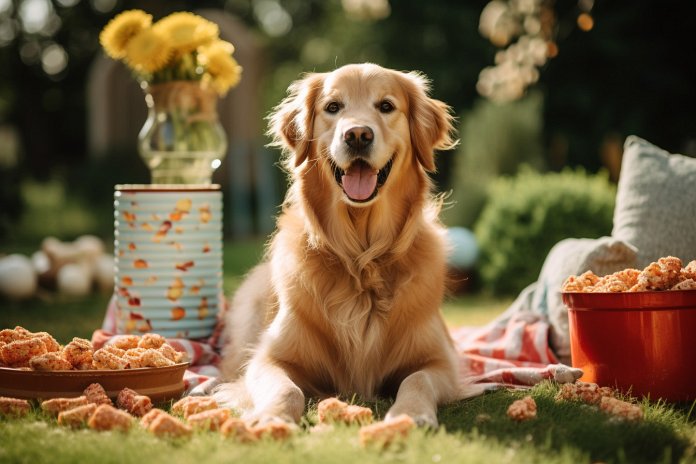
We all enjoy eating chewy foods like candy, jerky, popcorn, and fried snacks. Our dogs also seem to like chewy stuff, with dog biscuits being a common favorite. However, not all chewy foods are good for dogs, as too much fried food can cause pancreatitis. But do dogs actually enjoy the taste of chewy food? Or do they simply like to gnaw on it because it reminds them of bones? Let’s find out.
Signs of Dogs Tasting Chewy Food
Sometimes, a dog’s eating habits can be confusing. They may eat things that would make us sick, yet also enjoy “human food” like chips and fried chicken. You can easily tell when a dog likes the taste of crispy food because they eat it eagerly and wag their tail. If they want more chewy food, they may appear alert, raising their ears or tilting their head. On the other hand, if a dog pushes a chewy food with their nose, they are likely searching for something better underneath it, indicating that they don’t enjoy the taste. Sometimes, a dog may simply not be hungry, so offering them another food they like can help determine if it’s the chewy food they dislike.
Body Language
Here are some signs that indicate a dog can taste and may even enjoy the chewy food in front of them:
– Alertness
– Barking
– Chewing
– Wagging tail
– Pacing
– Raised ears
Other Signs
Here are some additional signs that suggest a dog can taste chewy food:
– Pawing at the food
– Reacting differently to it compared to other foods
– Gobbling it up
History of Dogs Tasting Chewy Food
Throughout history, providing dogs with tasty and nutritious food has been a priority for responsible dog owners. Chewy foods have always been popular among dogs, as they remind them of bones and provide exercise for their jaws.
Science of Dogs Tasting Chewy Food
Dogs have around 1,700 taste buds, while humans have 9,000. This explains why dogs eat things we wouldn’t consider consuming. However, dogs can still taste, but it is not their main concern. Dogs have a much stronger sense of smell, which greatly influences their overall experience of eating. Aromatic chewy foods may elicit stronger reactions from dogs. Additionally, dogs may enjoy the smell of a chewy food even if it doesn’t taste good to us. Dogs can also detect different taste classifications, such as sweet, salty, sour, and bitter.
Some dogs are pickier eaters, such as Yorkies and Maltese breeds. Understanding your dog’s behavior and preferences can help determine how they perceive the taste of chewy food.
Training Your Dogs to Eat Chewy Food
As long as it’s healthy, dogs can eat chewy food. However, it’s important to limit their intake of fat and calories to prevent health issues like pancreatitis. Avoid giving them too much fried food, as it can cause serious problems. Feeding jerky or rope candy is also not recommended. Just like with ourselves, it’s crucial to avoid overloading dogs with fat and calories, regardless of how tasty the chewy food may be. Consider your dog’s size and age when determining the right meal portions to prevent them from gaining excess weight.
It’s worth noting that maintaining good feeding habits is important whether or not you give your dog chewy food. Puppies younger than 4 months should be fed three times a day, while those older than 4 months can be fed twice a day. Some trainers and behaviorists suggest that humans should eat before their dogs to demonstrate leadership.
“A wagging tail and raised ears are just some of the signs that your dog can taste and enjoy chewy food.”

Tips & Things to Know
1️⃣ Pay attention to your dog’s body language when it comes to chewy food. Look for signs of enjoyment such as wagging tail, raised ears, and alertness. If your dog is pushing the food around with their nose or pawing at it, they may not like the taste and you should try offering them something else.
2️⃣ Dogs have a weaker sense of taste compared to humans, but a stronger sense of smell. The smell of chewy food can greatly influence their enjoyment of it. If a chewy food item smells good to your dog, they may still eat it even if it doesn’t taste great. Keep this in mind when offering different types of chewy food to your dog.
3️⃣ While chewy food can be a tasty treat for your dog, it’s important to maintain good feeding habits and portion control. Avoid giving your dog too much fried or fatty food, as it can lead to health issues such as pancreatitis. Consider the size and age of your dog when determining the right meal portions, and establish a regular feeding schedule to promote healthy eating habits.
Frequently Asked Questions, Answered ✅
1. What are some signs that indicate a dog enjoys the taste of chewy food?
– Eating the chewy food without hesitation
– Wagging their tail
– Appearing alert and raising their ears
– Barking or showing impatience for more chewy food
2. How can you tell if a dog does not like the taste of a chewy food?
– Pushing the food around with their nose
– Searching for something better underneath it
– Reacting differently to it compared to other foods
3. How many taste buds do dogs have compared to humans?
– Dogs have around 1,700 taste buds, while humans have 9,000 taste buds
4. How does smell play a role in a dog’s experience of chewy food?
– Dogs have a sharper sense of smell, so the aroma of the chewy food can strongly influence their reaction to it
5. How should you train your dog to eat chewy food?
– Limit the intake of fat and calories
– Avoid giving them too much fried food to prevent pancreatitis
– Consider the size and age of the dog to determine the right meal portions
– Maintain good feeding habits and demonstrate leadership through consistent meal times